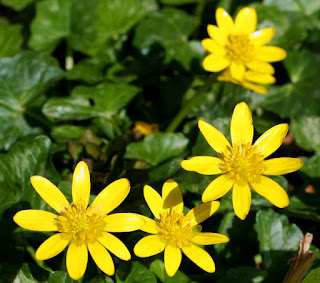My hammering technique is a little rusty and not as thorough as it could have been but this is what we found.
Clockwise from top left.
Muscari (grape hyacinth) - very sappy and it is best to strip the little bells from one side of the stem first and lay it with the stripped side uppermost before hammering. Although it doesn't produce a sharply defined outline the blue pigment transfers well and the little bells can be used individually to punctuate or infill other designs.
Forsythia - the colour was a surprise being very more mustard than the bright yellow of the flowers. The four petals made quite a stark cross but I felt they would be worth trying in a formal pattern with other smaller flowers in between.
Perennial wall flower - the flowers are a deep rusty red and produce a dark brown imprint with well defined edges.
Pineapple sage flowers - I love the bright lipstick red of these flowers and they printed as reddish-pink.
Scented Pelargonium flowers - A little bit disappointing but probably worth a more determined try.
Viola - this print shows how lack-lustre my hammering technique has become and somehow the fresh flower excused itself and disappearedfrom the edge of the board in the time between arranging this shot and picking up the camera - something I only noticed after I began reviewing my shots. Check below in this post to see how effective these flowers could be.
Chaenomeles (flowering quince) - very effective prints with good colours and definite edges.
Lesser Celandine - The colour transfer was good but I was surprised at how blurry the edges were. We tried it again throughout the afternoon with similar results.
Kerria - This is such a messy tousled flower that I would have given it a miss for this technique but Sue tried it and found that it did imprint quite well, including the stem, buds and leaves.
Oxalis leaf - very effective imprints when thorough hammering applied.
Herb Robert leaf - good results, the leaves are such delicate pretty shapes. I think discarding the larger stems is a good idea as it tends to produce a coarser line which detracts from the delicacy of the leaf imprint.
 |
| Sue's first try |
As for corduroy - with a viola and methodical hammering, what an effective result!
 | |
| Viola on corduroy |





